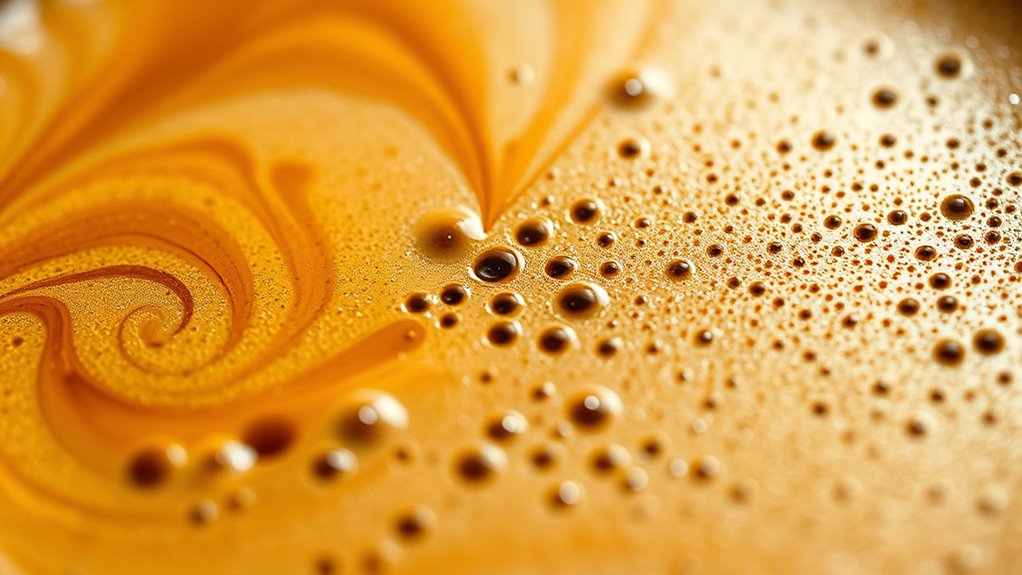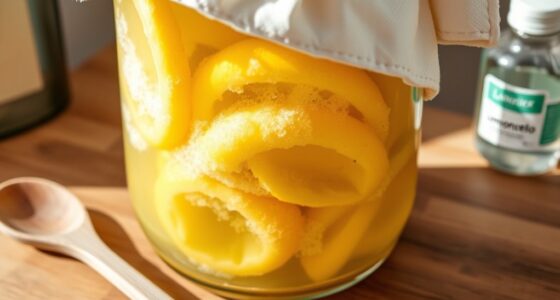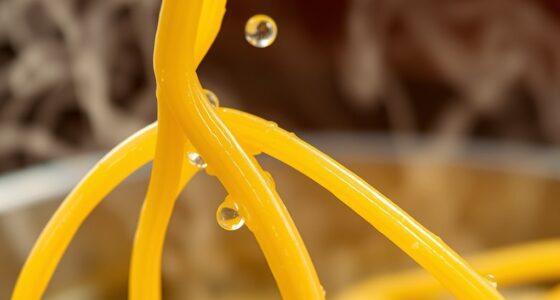The chemistry of espresso crema revolves around the formation of a complex emulsion during high-pressure brewing. As hot water extracts oils, proteins, and carbohydrates from the coffee, it traps gases like carbon dioxide within tiny bubbles, creating that thick, golden foam. Factors like grind size, pressure, and bean freshness influence its stability and appearance. If you want to understand how these components interact to produce perfect crema, there’s more to uncover below.
Key Takeaways
- Espresso crema forms as a complex emulsion of oils, proteins, carbohydrates, and trapped gases, primarily carbon dioxide, during high-pressure brewing.
- Hot water dissolves soluble compounds from coffee grounds, and pressure helps trap gases, creating tiny bubbles that form the foam.
- Gas retention and incorporation depend on bean freshness, grind size, and brewing parameters, influencing crema’s stability and appearance.
- Proper grind size and pressure balance are essential to prevent over- or under-extraction, ensuring rich, velvety crema.
- Crema indicates extraction quality, preserves aromatic oils, and reflects the chemical interactions occurring during espresso brewing.

Espresso crema is a complex emulsion that forms when hot water rapidly passes through finely ground coffee under high pressure. This process creates a rich, golden-brown foam on top of your espresso shot that’s both visually appealing and packed with flavor. The formation of crema hinges on several chemical and physical factors, with coffee solubility and gas entrapment playing critical roles. As hot water interacts with the coffee grounds, it dissolves soluble compounds, like oils, proteins, and carbohydrates, but not everything dissolves uniformly. Some compounds are highly soluble, releasing their flavors quickly, while others are less soluble, contributing to the body and mouthfeel of the espresso. The solubility of these compounds is influenced by temperature, grind size, and brewing pressure, which is why espresso machines operate at high pressure to optimize extraction.
Gas entrapment is equally essential in creating crema. Coffee beans naturally contain gases—mainly carbon dioxide—that are trapped within the cellular structure of the beans. When you brew espresso, the hot water rapidly extracts these gases, forcing them out of the coffee grounds and into the brew. Because of the high pressure, these gases don’t escape immediately but instead become trapped in tiny bubbles within the liquid. This process results in the foam-like layer known as crema. The quality and stability of crema depend heavily on how effectively these gases are retained and incorporated into the emulsion. Freshly roasted coffee beans tend to contain more trapped gases, producing thicker and more persistent crema compared to stale beans.
The interaction between coffee solubility and gas entrapment also affects the crema’s texture and longevity. If the grounds are too fine, extraction becomes overly intense, potentially breaking down the foam and reducing crema stability. Conversely, if the grind is too coarse, extraction may be insufficient, leading to thin or weak crema. Proper tamping and pressure ensure that water flows evenly through the grounds, maintaining the balance needed for ideal solubility and gas retention. When done correctly, the result is a dense, velvety crema that not only looks inviting but also preserves the aromatic oils and flavors that make espresso unique. Understanding these chemistry aspects helps you appreciate why a well-prepared espresso’s crema is more than just a visual cue—it’s a marker of the intricate chemical dance happening during extraction.
Frequently Asked Questions
How Does Water Mineral Content Affect Crema Formation?
You might notice that water mineral content impacts crema formation because mineral interactions influence coffee extraction. When minerals like calcium and magnesium are present, they help stabilize the coffee oils, creating a richer, more stable crema. Too many minerals can cause over-extraction, leading to bitterness, while too few may produce a thin, weak crema. Adjusting mineral levels in your water helps you achieve the ideal balance for better espresso quality.
What Role Do Atmospheric Conditions Play in Crema Stability?
A picture is worth a thousand words, so imagine the delicate dance of espresso crema. Atmospheric conditions like air pressure and humidity effects play a vital role; high humidity can cause the crema to break down faster, while low air pressure may reduce its stability. You’ll notice that in humid environments, crema tends to be less resilient, so adjusting your brewing process helps maintain its rich, velvety texture.
Can Non-Coffee Ingredients Influence Crema Quality?
Non-coffee ingredients can influence crema quality by affecting its stability and appearance. Milk proteins, for instance, can interact with espresso’s oils, creating a richer, more stable foam. Bean oils contribute to crema’s richness and smoothness, but added ingredients like milk or flavorings might disrupt this balance. You should consider how these components interact to maintain or enhance crema, ensuring a desirable, long-lasting crema layer.
How Does Grind Size Impact Crema at a Molecular Level?
It’s no coincidence that grind size directly impacts crema, as smaller particles create a larger surface area, increasing surface tension. When you use a finer grind, these tiny particles trap gases more effectively, forming a rich, stable crema. Conversely, coarser grounds reduce surface tension, making crema thinner and less persistent. Particle size therefore influences the molecular interactions that govern bubble formation, stability, and ultimately, the crema’s texture and appearance.
What Chemical Changes Occur During Crema Aging?
When crema ages, you experience chemical oxidation, which causes it to lose brightness and develop off-flavors. Proteins in the crema also undergo denaturation, altering their structure and affecting stability and aroma. These chemical changes lead to a duller appearance and diminished flavor quality over time. As you wait, the molecular interactions shift, reducing the crema’s freshness and creating a less appealing espresso experience.
Conclusion
As you savor that rich crema, remember it’s more than just a pretty layer; it’s a symphony of chemistry in motion. The delicate balance of oils, proteins, and carbon dioxide creates a fleeting masterpiece—an ephemeral whisper of flavor and aroma. So, next time you indulge, appreciate the science behind each velvety sip, for it’s this intricate dance of molecules that transforms simple coffee into an artful experience—an ode to the alchemy of espresso.









